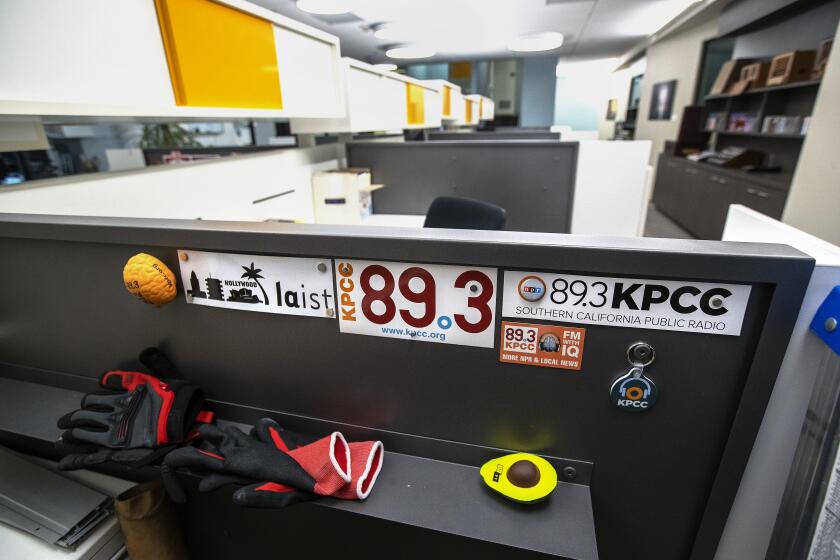Locked Out at the Gate : Airlines: Southwest wants to expand in the California market, but the lack of landing slots at major airports is frustrating the feisty carrier.
If Southwest Airlines had its druthers, it would muscle itself much more deeply into the California market. But, not unlike rush-hour strap-hangers on New York subways or drivers on the Santa Monica Freeway, it can’t find the breathing room.
Example: A number of gates at Los Angeles International Airport are under-utilized or not used at all. But they are on long leases to other airlines that are not about to allow any incursions by feisty competitors such as Dallas-based Southwest.
“We’d like to expand in California. . . . That’s one of our No. 1 priorities,” said Herbert D. Kelleher, Southwest’s chairman and president, in an interview. But “it’s not just an L.A. problem. It’s a California problem. The biggest limitation upon our expansion . . . is the unavailability of gates. . . . And, if you don’t have terminal facilities, you can’t provide more flights. And that’s true in San Diego. That’s true at LAX. That’s true at San Francisco. And, you know, it just goes on and on.”
Example: Southwest applied for landing slots at John Wayne Airport in Orange County. It had hoped for 15; it was offered five. Late last year, it turned them down, on the grounds that five gates were not enough to allow a low-cost airline like Southwest to make any money.
“We are basically a high-frequency, low-fare airline,” Kelleher said. “With only five slots, we would be converted into a low-frequency, high-fare airline.”
For a while anyway, Southwest’s competitors in California can breathe a bit easier, for it will be some time before it becomes a major threat to the likes of United Airlines, USAir and American Airlines in the California market.
Right now, Southwest isn’t a force to be reckoned with in the state, operating a meager 3% of the capacity in the hotly contested California corridor. But it sent a shiver through the opposition recently when it announced its new 10-flights-a-day service between Oakland and Burbank with fares no higher than $59 each way.
“We would dearly like to expand our presence in the California market,” said Gary C. Kelly, Southwest’s vice president-finance and chief financial officer. “But right now it seems like nothing but wishful thinking.”
Because of its uniqueness--indeed, it is a contrarian in the U.S. airline industry--Southwest is able to offer much lower fares than its competitors. Thus, laments Kelleher, Californians and his airline are both losers as a result of the scanty gate and landing space in the Golden State. The airline serves five California markets: Los Angeles, Oakland, Ontario, San Diego and San Francisco. On April 16, it will inaugurate the Burbank-Oakland service.
California markets “are very prosperous markets,” Kelleher said. “The other airlines are overpriced. We enable a lot more people to fly, at a lower fare, and a lot more people to fly more often than they otherwise would.”
And it’s no exaggeration that Southwest is able to charge less to fly.
On Jan. 31, the airline instituted a top fare of $59 on all flights within California, about 64% lower than the ordinary coach fares previously charged by airlines in the state. And some of Southwest’s fares are as low as $19 if passengers make reservations far enough ahead.
Don’t other carriers match Southwest’s fares when they compete on the same routes?
Certainly, Kelleher concedes, but on a very restricted basis. “There are no limits on the number of seats we offer at $59,” Kelleher said. “The others limit the number of seats at that low price. The result is that our (average) fares are about one-third lower than what the other carriers charge.”
That’s possible because Southwest’s operating costs are by far the lowest in the industry. It cost Southwest 6.2 cents a seat for every mile flown last year, compared to 6.99 cents for America West Airlines, 8.01 for American, 8.44 for Delta Air Lines, 8.92 for United, 10.52 for USAir and 10.68 for Alaska Airlines.
“This is an airline that is run in a very disciplined manner,” said airline analyst Hans J. Plickert who is with the Transportation Group, an affiliate of Paine Webber, a New York investment firm. “It has stuck to its knitting: relatively short-haul and relatively high-frequency transportation, and it has steadily grown on those principles. . . . Southwest is able to make a much better operating profit margin than other carriers.”
Southwest is able to keep its belt that tight because of what Kelleher calls a “concatenation of several factors,” the most important of which is probably that it gets so much use out of its airplanes.
Southwest turns its planes around as if they were the airline version of cars racing in the Indianapolis 500, which make pit stops often lasting only 15 to 20 seconds. Southwest’s smaller aircraft, Boeing 737-200s configured for 122 passengers, spend only 10 minutes at the gate. The larger ones, 737-300s that carry 137 passengers, are sent on their way in 15 minutes. That compares to 30 to 45 minutes for most other airlines.
Non-restrictive work rules, which other carriers don’t have, are probably the most important reason this can be achieved. Southwest’s employees are unionized, but Kelleher said they “are free to help one another. (That) achieves efficiency.”
It is not unusual for a Southwest mechanic, seeing an airplane falling behind schedule, to help with baggage loading. Or pilots might board passengers when operations agents are overburdened. It’s even not unknown for a pilot to help clean an airplane’s cabin after a flight to allow quicker reboarding.
The speedy turnaround alone accounts for monumental savings. Without it, Kelleher calculates, Southwest (which serves 30 cities in 14 states) would need eight additional 737s at a total cost of about $200 million. Spare parts for that many planes would cost another $30 million.
The savings: $23 million annually in interest alone, he figures.
Fleet commonality is another reason and may be almost as important. Other carriers fly fleets that include everything from 727s to 747s, 757s and 767s--all made by Boeing--as well as McDonnell Douglas MD-80s and DC-10s. Southwest flies only 737s, with a fleet consisting of 46 737-200s and 48 737-300s. It is waiting for two more 737-300s and 10 new 737-500s.
Flying one kind of airliner, Kelleher said, saves the airline great amounts of money in training pilots and mechanics, and allows pilots to be switched easily between aircraft. The smaller inventory of spare parts needed saves money, as does the interchangeability of engines. And having a one-type fleet makes planning the airline’s schedule much simpler.
With the youngest fleet in the industry (the planes average 5 1/2 years old) Southwest also burns much less fuel per plane, an important factor with the burgeoning cost of jet fuel.
Southwest is different from other airlines in other significant ways.
* It has no hubs, flying only straight-line routes between individual cities.
* It usually avoids major city airports. Instead, it uses smaller fields--such as Dallas’ Love Field, Houston’s Hobby, Detroit International, Ontario and Oakland--that generally are less busy and much closer to downtown areas, allowing business people to get to their appointments much quicker.
* It does not “interline” with other airlines, making such things as single ticketing and checking baggage to a final destination impossible if a trip involves more than one airline. But it saves money for Southwest.
* It flies mostly short flights very frequently. The average length of a Southwest flight is 540 miles, and 45% of its passengers fly less than 600 miles. So it does not have first-class sections and has no intention of changing that policy. “If you’re flying for 30 minutes,” Kelleher said, (you) “won’t pay an extra $20 or $30 for first class.”
“We’re primarily in the business of satisfying the needs of the person who is making a relatively short journey,” Kelleher said, “customarily returning on the same day, doing it on a nonstop basis. We have more nonstop destinations than any other carrier, because the other carriers are flying through their hubs to circulate passengers.”
Southwest has not done too badly, even without a major share of the California market. Launched in 1971 with three 737s offering six round-trip flights between Dallas and San Antonio, it has, according to its chairman, been consistently profitable.
“We have been uniformly profitable since 1973,” Kelleher boasted, “have never had a losing year. There’s no other carrier that can make that statement. We had our second consecutive year of record profits last year with $71.6 million, surpassing the $58 million--which was a record--in 1988. It’s unusual, but our focus has always been not on size, but on profitability.”
Ever-increasing profits usually don’t come without ever-increasing revenues, and last year Southwest’s operating revenues reached $1 billion, an important plateau in the airline business. The Transportation Department defines any airline with revenues surpassing that figure as a “major” airline, so Southwest, the nation’s ninth-largest carrier, now has that status.
But Kelleher shrugged off the honor.
With some sarcasm and a certain display of ego, he said Southwest could have been a “major” five years ago had its low fares not cut heavily into its revenue.
Southwest has always been deadly serious about its business, about making a profit. But it also wants to be known as an airline that’s fun to ride. In its early days, its flight attendants wore miniskirts.
These days, Southwest sometimes conducts Halloween costume contests among its flight attendants, and at other times the attendants make their cabin announcements by singing them. And in-flight contests make passengers sit up and listen: “Anyone with a 1929 nickel wins a free round trip.”
Even the annual report can be fun: The inside back cover of the 1988 report had a paper cutout of a Southwest 737.






